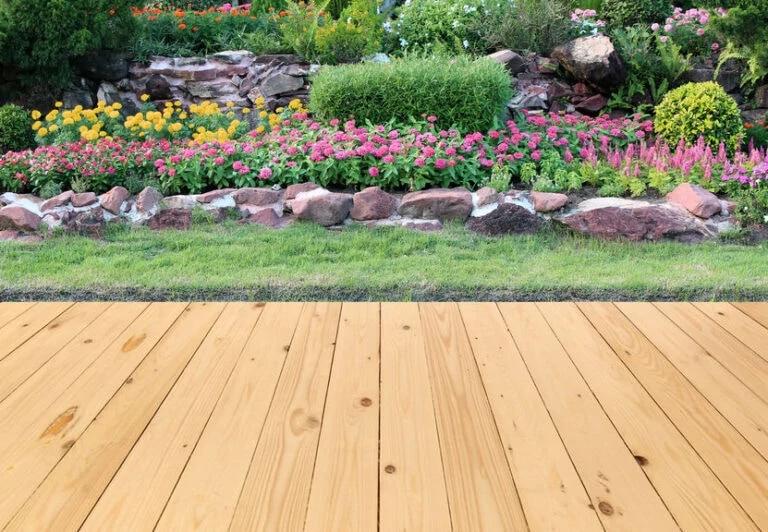Design Elements
A well-designed landscape will incorporate the following:
Unity is the principle that ties the landscape together as a whole. To achieve unity, resist the urge to have one of each variety in every color. Repeating the same plants in various parts of the landscape gives unity. As tough as it sometimes is, try not to buy a plant, take it home, and then decide where to put it.
Balance can be formal (symmetrical) or informal (asymmetrical), but it should achieve exactly what the word means — even distribution or equality. In a symmetrical design, the left side will be a mirror image of the right side. An asymmetrical design would not be identical on each side, but would have equal points of interest.
Proportion addresses the need to keep the landscape features in scale with the house. It is critical to keep the ultimate size of a tree or shrub in mind when selecting one for planting. That 8-foot tall maple tree at the garden center may be 20 feet tall in a few short years, on its way to up to 100 feet. Proportion also applies to smaller plants. A faster-growing neighbor can easily hide smaller shrubs, perennials and other plantings.
Design Principles
Form — Plants large and small have various forms, each offering something different to the landscape. They can be weeping, round, pyramidal, spreading, oval, vase or columnar. Look at trees for example. In addition to a tree’s form during the growing season, consider how much shade it will provide and where the shade will be during the spring and summer. If it’s a deciduous tree, imagine how it will look without leaves in fall and winter.
Line — Whether curved or straight, lines are used to draw your eye towards a focal point or to separate areas of the garden. Establishing bed lines is one of the first things to do when designing a landscape.
Texture — Leaves, flowers, stems all have texture. Finding plants and features that contrast or complement is basic to a good garden design. Foliage that is lacy in appearance would highlight a plant with more rounded leaves. Consider the year-round appearance of your prospective plants.
Color— Color is the most obvious aspect of the landscape and may be the least understood. A well-designed landscape can look good without any color (other than green). Color used wisely will accent your garden, while too much color can appear harsh or grating. When deciding which plants to use, keep color in mind just as you would when painting your home. The house is almost always the dominant feature of your landscape. The color of your plantings should complement your home’s color. When choosing flowers, for example, consider the almost infinite combinations of color, the flower and foliage shapes, the timing of blooms and their duration, and the height of the plants. Decide whether you prefer the instant gratification of annuals versus the long-term investment of perennials, or a combination of both.
Planning Your Landscape
Now that you’ve got the basics down, you need a plan. Decide what you want and need. What are your priorities? Is it entertaining friends, playing with the kids, growing flowers and vegetables, or simply relaxing in a hammock? How much maintenance are you willing to do? Determine what you have to work with. There are some aspects of your landscape that you cannot or do not want to change.(Driveways and large trees for example). Also remember your budget constraints. Remember that the landscape may have to develop in stages. Make a map of your property. Draw a “bird’s eye view” to scale on graph paper (see Graph Paper). Be sure to include:
- The house itself
- Boundaries, noting the neighbor’s landscape style as well
- Existing plants
- Exposure (which way does it face – north, south, east, or west)
- Utilities (dryer vents, air conditioner/heat pumps)
- Service areas (dog kennel, storage building, trash cans)
- Views you wish to preserve or hide
- Downspouts and drains
- Grades/slopes/drainage
- Any existing irrigation systems
Use tracing paper to draw your ideas. These could include plants, a gazebo, a walkway, an orchard, a pond, or sculpture. Lay the tracing paper over the map to get an idea of how the new landscape will look. (Let the whole family do a design; you may be surprised at the ideas you get!)
- Always consider the mature size of any plantings.
- Think about the neighborhood itself, will your new landscape fit in with the rest of the homes on the street? (If resale value is an issue).
- Do you have limited space? If so, try vertical garden accents such as fences with vines. Plantings in containers also work in small areas.
- Are there steep or sloped sections? Terraces or ground covers can help.
- Do you want your landscape to have a theme? Match your landscape to your personality – are you formal or informal, public or private?
- Are there individuals with special needs in your household that could benefit from easier access? Raised beds or wider paths may be the answer.
- What is the view from inside your house?
- Do you enjoy wildlife? There are numerous plants and features that can attract butterflies, hummingbirds, songbirds, and other wildlife to your yard.
That’s a lot of information, but don’t let it discourage you. Just remember to be patient. You will become discouraged (and exhausted) if you try to do it all at once. A landscape is truly a work in progress, so give it time to develop. One last thing, remember rules are made to be broken. It’s your yard. Have Fun.



